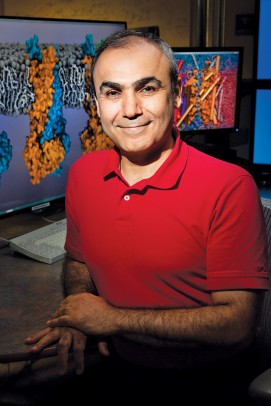Understanding molecular basis of disease to design better drugs
Emad Tajkhorshid was surprised to win a University Scholar award — and even more so when he learned he was nominated by two campuses.
“This university is one of the top in the world so being a scholar on any campus is a great honor,” said Tajkhorshid, professor of biophysics, biochemistry and pharmacology. “But being nominated by two was the cherry on top. I really love this university and the students and it was very nice, actually a great honor, to be recognized by both campuses.”
Tajkhorshid has a dual appointment with the UIC and Urbana campuses. He teaches in Urbana through the UIC College of Medicine but most of his research work is conducted with Urbana’s department of biochemistry and Beckman Institute for Advanced Science and Technology.
Tajkhorshid received his doctoral degrees in Iran and Germany, then traveled to Urbana in 2000 to begin his postdoctoral research work.
“I fell in love with this place, so I never moved,” he said.
In his research, Tajkhorshid uses computer modeling to study the molecular basis of disease and drug action. His work focuses on the structure function relationship of membrane proteins, such as membrane channels and transporters.
“We use computational methods and modeling to understand how biological systems work,” he said. “Understanding the molecular basis allows us to design much more specific drugs.”
He teaches a course on principles of pharmacology for second-year UIC College of Medicine students on the Urbana campus, as well as a computational course for biology, chemistry and engineering students.
“I really love to teach and to be able to transfer my knowledge to students,” he said.
“In addition to my research, I’ve been very interested in developing the next generation of materials for future classrooms in biology and engineering. We use real animation models to create interactive lecture materials.”
Medical school classes require a lot of memorization, so Tajkhorshid tries to engage his students visually.
“When possible, I show them animations and other molecular visualization materials from my own research, even unpublished results,” he said. “It visually helps them remember when they have seen this protein flipping back and forth. It’s easier to distinguish if you’ve seen it.”

